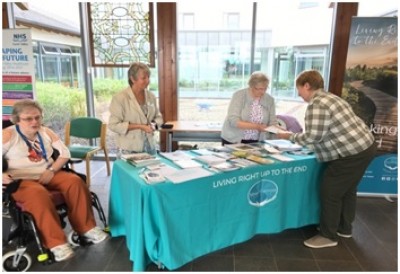Strathcarron Hospice “Living Right up to the End” project
Strathcarron Hospice “Living Right up to the End” project
Talking about end of life – overcoming the barriers to community engagement.

Death, dying and bereavement are part of life, but are often seen as taboo in modern society and as a result, people miss opportunities to talk about and plan for the end of life. The Scottish Government recognised this in their Strategic Framework for Action for Palliative and End of Life care. A key outcome of the framework is that “People have opportunities to discuss and plan for future possible decline in health, preferably before a crisis occurs, and are supported to retain independence for as long as possible.”
In 2015 Strathcarron Hospice received funding from the Health and Social Care Alliance to find out what would help people to self-manage in the last year of their life so that they feel able to live well right up to the end. The Strathcarron Hospice Community Development Team set out to work with people living with long term conditions and their carers. Our aim was to find out from the people affected what would help them to live well through the challenges of declining health, and to work with them to develop community solutions.
We started by creating an asset map of the resources available in the project areas. This process revealed an array of community groups and activities which we had previously been unaware of.
Initially we identified the groups which had obvious relevance to people living with long term conditions. We approached these groups to ask them to participate in discussion. We encountered considerable reluctance to engage. The group leaders were protective of their members, making a decision on their behalf that the subject matter was too difficult.
Clearly a different approach was required.
We invested time and energy in making ourselves known and trusted in the communities. We attended third sector network events, community meetings, carers forum meetings, even a singing for memories group. We made friends and influenced people. At every opportunity we spoke about “LIVING right up to the End” and our genuine interest in hearing people’s views. We found that the Strathcarron brand was helpful as it was known and trusted, but also a hindrance because people had many misconceptions, and associated it with very end of life.
With the help of some key community players we managed to arrange events in local community venues. We provided tea and cake, and transport if required.
We asked ordinary people who had living or lived experience of the challenges of declining health about what was important to them as they approach the latter stages of life. We also asked them about the barriers to thinking about and planning for the future.
Once we had gained their trust we were overwhelmed by the willingness to share very personal experiences and thoughts.
We invited participants to join groups who would work with us over a period of 4 months to help us to really understand not only what the issues were, but also what they felt would help them. Over the 4 month period we witnessed something remarkable. The participation groups became safe places for discussion of sensitive and difficult subjects. The group supported, encouraged and respected each other.
Individuals who had initially been anxious about engaging with “the hospice” gave us feedback on the experience of being involved in the project.One participant commented that she was often asked for feedback but had never previously felt her contribution was valuable.
Together we worked through the barriers to thinking about and planning for the future. The group felt that although they knew it was a good thing to do, they didn’t know where to start or what they should be planning for. Some had been given information by health professionals but they felt this was often given at the wrong time, or was in the wrong language. There was a strong feeling that they would not use the internet for “something as important as this” although they were happy to use it for other purposes.
The community development team gathered a large variety of materials and resources related to planning for the future, planning for end of life, and having the necessary but difficult conversations with loved ones about these plans. From these resources the participants agreed the ones which they felt would be most helpful to most people. Some participants liked the national ACP tool and were keen to use it, others felt it was “too formal, you would need professional help to fill that in.”

The resources identified were made available on “pop up information stands” which were provided at local GP surgeries. The group participants were keen to make it clear that there was no need for a professional at the pop up stands. The participants felt they were well placed to listen and respond to questions from the public.
Some of the group participants have become “ambassadors” in their local communities. They actively promote the importance of talking openly about death, dying and bereavement. They seek out venues for the information stand, and suggest changes to the materials provided in response to what they find works well.
The full report of the Living right up to the end project is available here: Living right up to the end report
Strathcarron Hospice community development team continues to explore new ways of supporting communities and individuals to manage the challenges faced in the latter stages of life.
For further information please contact Susan High, tel: 01324 826222
By Susan High, Community Development Co-ordinator, Strathcarron Hospice